Question
Which of the following is
true? Answer the questions based on the information given below. Eight persons P, Q, R, S, T, U, V and W are sitting around a circular table facing inside but not necessarily in the same order. All of them likes different flowers viz. Lily, Rose, Marigold, Daisy, Jasmine, Lavender, Lris and Pansy but not necessary in same order. Only one person sits between T and the one who likes Lily. P sits second to the left of the one who likes Lily. W is an immediate neighbour of R. R is not an immediate neighbour of P or T and he does not likes Lavender. T sits second to the left of the one who likes Lavender. Only three people sit between the one who likes Rose and the one who likes Marigold. U sits second to the left of the one who likes Marigold. W does not likes Daisy. The one who likes Daisy is not an immediate neighbor of W. S sits on the immediate left of the one who likes Daisy. The one who likes Lris sits on the immediate right of the one who likes Pansy. Only two persons sit between V and the one who has likes Lavender. The one who likes Rose sits second to the right of W.Solution
Only one person sits between T and the one who likes Lily. P sits second to the left of the one who likes Lily. If the one who likes Lily sits at place no.1, then P sits at place no. 7 and T sits at place no. 3. T sits second to the left of the one who likes Lavender. So, the one who likes Lavender at place no. 5. 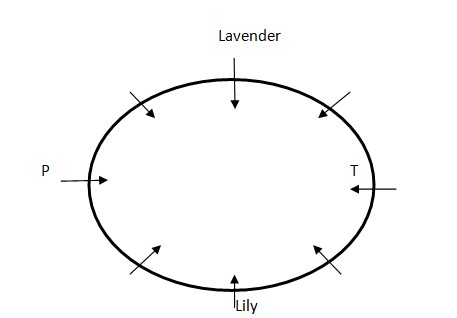 Only two persons sit between V and the one who has likes Lavender. From this statement, we will have two cases: V will sit either at place no. 2 or 8. W is an immediate neighbour of R. R is not an immediate neighbour of P or T and he does not likes Lavender. The one who likes Rose sits second to the right of W. R cannot sit at place no. 6, 5, 4 and 8. So, only place left for him is place no. 1. As W is an immediate neighbour of R. So, W will sit either at place no. 8 or 2. The one who likes Rose sits either at place no. 4 or 2. Only three people sit between the one who likes Rose and the one who likes Marigold. So, the one who likes Marigold sits either at place no. 6 or 8. U sits second to the left of the one who likes Marigold. So, U sits either at place no. 4 or 6. Case-1
Only two persons sit between V and the one who has likes Lavender. From this statement, we will have two cases: V will sit either at place no. 2 or 8. W is an immediate neighbour of R. R is not an immediate neighbour of P or T and he does not likes Lavender. The one who likes Rose sits second to the right of W. R cannot sit at place no. 6, 5, 4 and 8. So, only place left for him is place no. 1. As W is an immediate neighbour of R. So, W will sit either at place no. 8 or 2. The one who likes Rose sits either at place no. 4 or 2. Only three people sit between the one who likes Rose and the one who likes Marigold. So, the one who likes Marigold sits either at place no. 6 or 8. U sits second to the left of the one who likes Marigold. So, U sits either at place no. 4 or 6. Case-1 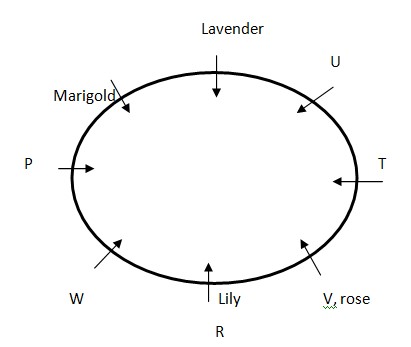 CASE-2
CASE-2 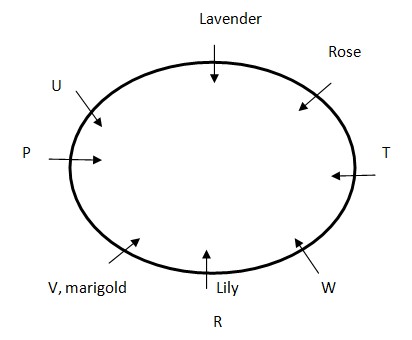 W does not likes Daisy. The one who likes Daisy is not an immediate neighbor of W. S sits on the immediate left of the one who likes Daisy. The one who likes Lris sits on the immediate right of the one who likes Pansy. Case 1 will get discarded as the one who likes Daisy cannot sit at place no. 7 and 8. If the one who likes Daisy sits either at place no. 4 or 3, then there is no place for S as S sits on the immediate left of the one who likes Daisy In case 2, if the one who likes Daisy sits at place no. 6, then S sits at place no. 5. The one who likes Lris and the one who likes Pansy sit at place no. 3 and 2 respectively Only person left for place no. 4 is Q. Only flowers left for P is Jasmine Case-1
W does not likes Daisy. The one who likes Daisy is not an immediate neighbor of W. S sits on the immediate left of the one who likes Daisy. The one who likes Lris sits on the immediate right of the one who likes Pansy. Case 1 will get discarded as the one who likes Daisy cannot sit at place no. 7 and 8. If the one who likes Daisy sits either at place no. 4 or 3, then there is no place for S as S sits on the immediate left of the one who likes Daisy In case 2, if the one who likes Daisy sits at place no. 6, then S sits at place no. 5. The one who likes Lris and the one who likes Pansy sit at place no. 3 and 2 respectively Only person left for place no. 4 is Q. Only flowers left for P is Jasmine Case-1 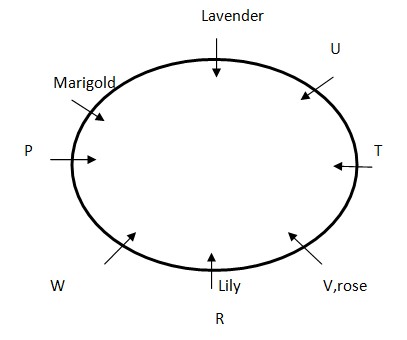 CASE-2
CASE-2 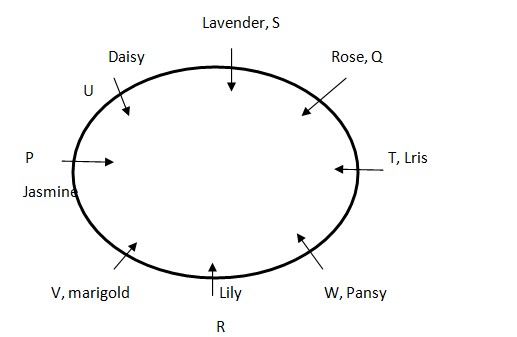 Final arrangement as shown below:
Final arrangement as shown below:
In each of the questions, a sentence is divided into five parts A, B, C, D and E in which two of the parts have some grammatical errors in them. You ha...
Though the overall figure for PHCs without (A)/electricity supply (5 per cent) may appearing to be low,(B)/ what is of concern is that these PHCs are (C...
In the question below, a sentence is given, divided into five parts (A) , (B) , (C) , (D) and (E) . One of the parts is grammatically incorrec...
Read the given sentence to find out whether there are any grammatical/contextual errors in them. The errors, if any, will be in two of the phrases of th...
Any mental health legislation should be more therapeutic, than legal and most humane than regulatory.
...In the following questions each sentence is divided into four parts. Read each sentence to find out if there is any error in it. The error, if any, wil...
The world is not kindly to those who do not tackle their own problems.
Read the sentence to find out whether there is any grammatical or idiomatic error in it. The error, if any, will be in one part of the sentence. If the...
It would be in the fitness of things (A)/if the Court took note of the attempts to use the incident (B)/for electoral propaganda and restrained (C)/poli...
Identify the segment in the sentence that contains a grammatical error.
The comedian / looked very funny that /the audience could not / control...
Relevant for Exams:



